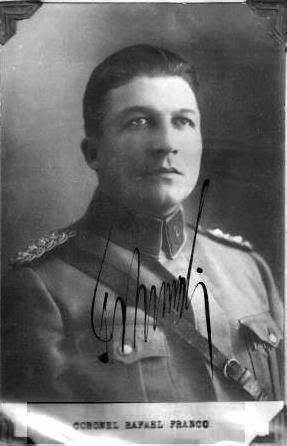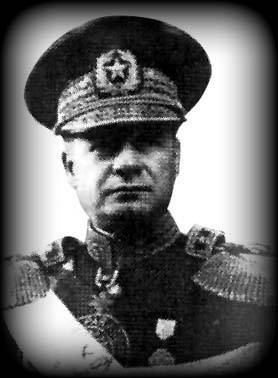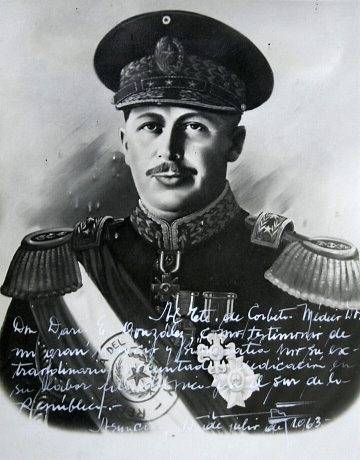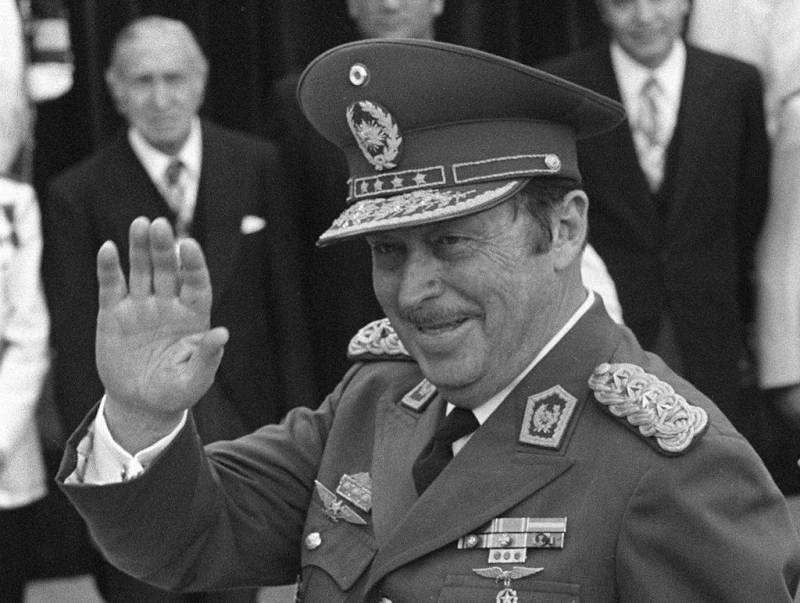Fuhrer Stroessner. Part of 1. How Paraguay became the American "condor"
The geographical position and historical features of the development of Paraguay largely determined its socio-economic backwardness in the twentieth century. Paraguay, deprived of access to the seas, was doomed to economic backwardness and dependence on the larger neighboring states - Argentina and Brazil. Nevertheless, in Paraguay, at the end of the 19th century, numerous emigrants from Europe began to settle down, first of all - the Germans. One of them was Hugo Strössner - a native of the Bavarian town of Hof, an accountant by profession. In local fashion, his name was pronounced as Stroessner. In Paraguay, he married a girl from a local wealthy surname named Heribert Matiauda. In 1912, their son was born - Alfredo. Like many other people from the Paraguayan middle class families, Alfredo from a young age dreamed of a military career. In Latin America in the first half of the twentieth century, the path of professional military promised a lot - and success with women, and respect for civilians, and a decent salary, and most importantly - opened up career opportunities that civilians lacked - except for hereditary representatives of the elite. At the age of sixteen young Alfredo Stroessner entered the national military school and three years later he graduated from it, receiving the rank of lieutenant. Further, the military career of a young and promising officer developed rapidly. This was facilitated by turbulent, by the standards of Paraguay, events.
In June, the 1932 started the Chak War - an armed conflict between Paraguay and Bolivia caused by Bolivia’s territorial claims to Paraguay — the Bolivian leadership hoped to seize the northern part of the Gran Chaco region, where promising oil fields were discovered. Paraguayan authorities, in turn, considered the preservation of the Gran Chaco region beyond Paraguay to be a matter of national prestige. In 1928, the first armed conflict occurred on the Paraguay-Bolivian border. A squadron of Paraguayan cavalry attacked the Bolivian fort of Vanguardia, 6 soldiers were killed, and the Paraguayans themselves fortified the fort. In response, Bolivian troops attacked Fort Boquerón, which belonged to Paraguay. With the mediation of the League of Nations, the conflict was resolved. The Paraguayan side agreed to restore the Bolivian fort, and the Bolivian troops were withdrawn from the area of Fort Boquerone. However, tensions in the bilateral relations of neighboring states continued. In September 1931, new border clashes occurred.
15 June 1932, Bolivian troops attacked positions of the Paraguayan army near the town of Pitiantouta, after which hostilities began. Bolivia initially possessed a stronger and well-armed army, but the position of Paraguay was saved by a more skilful leadership of the actions of its army plus participation in the war on the side of Paraguay by Russian émigrés — officers, military professionals of the extra class. Twenty-year-old Lieutenant Alfredo Stroessner, who served in artillery, took part in the hostilities during the war of Chak. The war between the two countries lasted three years and ended with the actual victory of Paraguay. 12 June 1935 was a truce.

Success in the war greatly strengthened the position of the army in Paraguay and further strengthened the position of the officer corps in the country's political elite. In February, 1936 in Paraguay, a military coup took place. Colonel Rafael de la Cruz Franco Ojeda (1896-1973) - a professional soldier, the hero of the Chak War came to power in the country. Starting his service as a junior artillery officer, Rafael Franco during the Chak war reached the corps commander, was promoted to colonel and led a military coup. According to his political views, Franco was a supporter of social democracy and, having come to power, he set up an 8-hour day in Paraguay, an 48-hour working week, he introduced compulsory leave. For a country like Paraguay at that time it was a very big success. However, Franco’s activities caused great discontent among the right-wing circles, and on August 13 of 1937, as a result of another military coup, the colonel was overthrown. The country was headed by “interim president” lawyer Felix Paiva, who remained at the head of state until 1939.
 In 1939, the new president of the country was General José Felix Estigarribia (1888-1940), who soon received the highest military rank of Marshal Paraguay. Coming from the Basque family, General Estigarribia initially received an agronomical education, but then decided to associate his life with military service and enrolled in a military school. For eighteen years, he was promoted to the chief of staff of the Paraguayan army, and during the Chak war he became the commander of the Paraguayan troops. By the way, his chief of staff was a former Russian service general, Ivan Timofeevich Belyaev, an experienced combat officer who commanded an artillery brigade on the Caucasian front during the First World War, and then a volunteer army artillery inspector.
In 1939, the new president of the country was General José Felix Estigarribia (1888-1940), who soon received the highest military rank of Marshal Paraguay. Coming from the Basque family, General Estigarribia initially received an agronomical education, but then decided to associate his life with military service and enrolled in a military school. For eighteen years, he was promoted to the chief of staff of the Paraguayan army, and during the Chak war he became the commander of the Paraguayan troops. By the way, his chief of staff was a former Russian service general, Ivan Timofeevich Belyaev, an experienced combat officer who commanded an artillery brigade on the Caucasian front during the First World War, and then a volunteer army artillery inspector. Marshal Estigarribia was not in power in the country for long - already in 1940, he died in a plane crash. In the same year, 1940, a young officer, Alfredo Stroessner, was promoted to major. By 1947, he commanded an artillery battalion in Paraguari. He took an active part in the Paraguayan civil war 1947 of the year, eventually supporting Federico Chávez, who became president of the country. In the 1948 year, in the 36 years, Stroessner was promoted to brigadier general, becoming the youngest general in the Paraguayan army. The command appreciated Stroessner for resourcefulness and diligence. At 1951, Federico Chavez appointed Brigadier General Alfredo Stroessner as Chief of Staff of the Paraguayan Army. At the time of appointment to this high position, Stressner was not yet 40 years old - a dizzying career for a military man from a relatively poor family. In 1954, 42-year-old Stressner was given the military rank of divisional general. He received a new appointment - to the post of commander in chief of the Paraguayan army. In fact, according to real opportunities, Stroessner was the second person in the country after the president. But this ambitious young general was not enough. 5 May 1954, divisional general Alfredo Stroessner led the military coup and after the suppression of short-term resistance from the president’s supporters seized power in the country.
In August, 1954, under the control of the army, held a presidential election in which Stroessner won. Thus, he became the legitimate head of the Paraguayan state and remained as president of the country until the 1989 year. Stressner succeeded in creating a regime with the appearance of democratic governance — the general held presidential elections every five years and invariably won them. But no one could accuse Paraguay of rejecting the democratic principle of electing the head of state. In the context of the confrontation between the United States and the USSR in the Cold War, the Americans treated the staunch anti-communist Stressner condescendingly and preferred to close their eyes to the numerous "vicissitudes" of the regime established by the general.

General Stroessner immediately after the coup that brought him to power, declared a state of emergency in the country. Since by law it was possible to declare it only for ninety days, every three months Stroessner again renewed the state of emergency. This went on for more than thirty years - until 1987. Fearing the spread of opposition sentiments in Paraguay, especially communist ones, Stressner maintained a one-party regime in the country until 1962. All power in the country was in the hands of one party - “Colorado”, one of the oldest political organizations in the country. Created back in 1887, Colorado remained the ruling party of Paraguay in 1887-1946, in 1947-1962. was the only party allowed in the country. In ideological and practical terms, the party "Colorado" could be attributed to the right-wing populists. It is obvious that many of the features of the party in the years of Stressner's rule were borrowed from the Spanish Franco and Italian fascists. In fact, only members of the Colorado party could feel more or less full citizens of the country. The attitude of the Paraguayans who failed in the party was initially biased. At least, they could not even count on any government posts or even more or less serious work. So Stroessner sought to ensure the ideological and organizational unity of Paraguayan society.
From the very first days of the establishment of the Stressner dictatorship, Paraguay was on the list of the main Latin American "friends of the United States." Washington provided Stressner with a huge loan, while American military specialists began training officers of the Paraguayan army. Paraguay became one of the six countries implementing the policy of Operation Condor - the persecution and liquidation of the communist and socialist opposition in the countries of Latin America. In addition to Paraguay, Chile, Argentina, Uruguay, Brazil and Bolivia were among the “condors”. American intelligence services provided comprehensive support and protection for anti-communist regimes. Fighting opposition in Latin American countries was considered at that time in Washington not as far as the observance or violation of civil rights and freedoms of a person is concerned, but as one of the most important components of counteracting Soviet and communist influence in Latin America. Therefore, Stroessner, Pinochet, and many other dictators like them received the actual carte blanche for carrying out large-scale repressions against dissidents.
Paraguay, if you do not take Pinochet's Chile, became one of the champions of Latin America of the twentieth century for the cruelty of repression. General Stroessner, who established a cult of his own personality in the country, did an excellent job with the task of destroying the communist opposition. Torture, disappearances of opponents of the regime, brutal political killings - all this was commonplace for Paraguay 1950's - 1980's. Most of the crimes committed by the Stroessner regime have not yet been disclosed. At the same time, being a tough opponent of the opposition in his own country, Stroessner generously provided asylum to hiding war criminals and overthrown dictators from around the world. In the years of his rule, Paraguay became one of the main shelters for former Nazi war criminals. Many of them in the 1950-1960-s continued to serve in the Paraguayan army and police. Being himself a German by birth, Alfredo Stroessner did not hide sympathy for the former Hitlerite military personnel, believing that the Germans could become the basis for the formation of the elite of Paraguayan society. For some time even the infamous Dr. Josef Mengele was hiding in Paraguay, what about a smaller rank about the Nazis? In 1979, the deposed dictator of Nicaragua, Anastasio Somoza Debeile, left for Paraguay. True, even on the Paraguayan territory, he was unable to hide from the revenge of revolutionaries - in the next 1980 year, he was killed by Argentine left radicals, acting on the instructions of the Nicaraguan SFLO.
The economic situation of Paraguay during the reign of Stroessner, no matter how the advocates of his regime tried to say the opposite, remained extremely difficult. Despite the fact that the United States provided enormous financial assistance to one of the key anti-communist regimes in Latin America, most of it either went to the needs of the security forces or settled in the pockets of corrupt ministers and generals.
Over 30% of budget funds were spent on defense and security. Stressner, ensuring the loyalty of different groups of the military elite, turned a blind eye to the numerous crimes committed by the military, and to total corruption in the security forces. For example, all the armed forces under his rule were integrated into smuggling. The criminal police controlled the drug trade, security forces - livestock trading, horse guards - contraband trade in alcohol and tobacco products. Stroessner himself did not see anything reprehensible in such a division of functions.
The vast majority of the Paraguayan population continued to live in dire poverty, even by Latin American standards. The country lacked a normal system of affordable education, medical services for the general population. The government did not consider it necessary to solve these problems. At the same time, Stroessner allocated land to landless peasants in previously uninhabited areas of Eastern Paraguay, which slightly reduced the overall level of tension in Paraguayan society. At the same time, Stroessner pursued a policy of discrimination and the suppression of the Indian population, who constituted the majority in Paraguay. He considered it necessary to destroy the Indian identity and the complete dissolution of the Indian tribes in a single Paraguayan nation. In practice, this turned into numerous killings of civilians, squeezing Indians out of their traditional habitat, removing children from families for the purpose of selling them to farm laborers, etc.
To be continued ...

Information